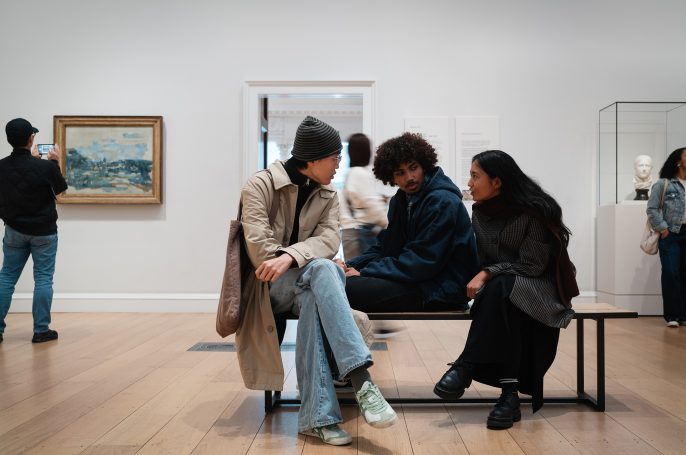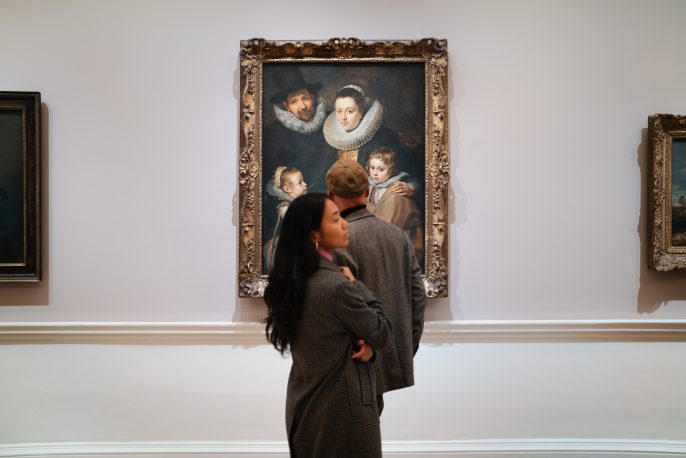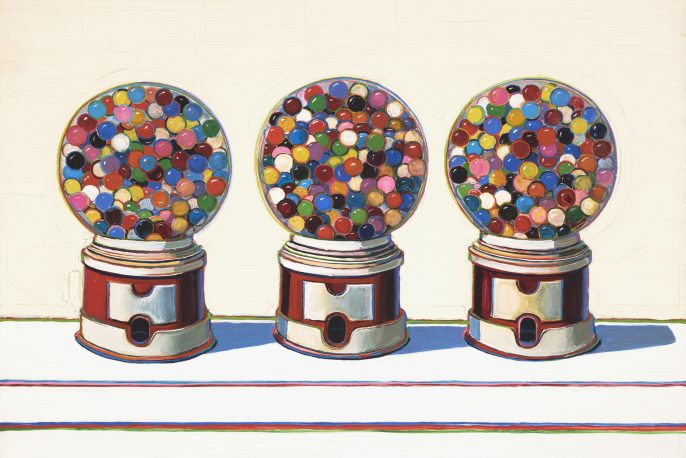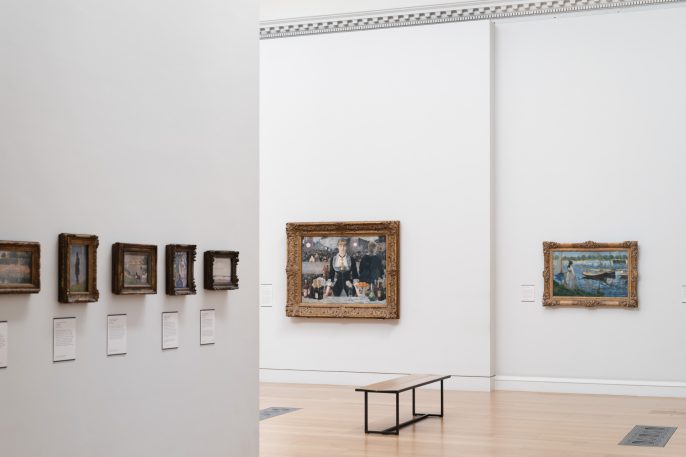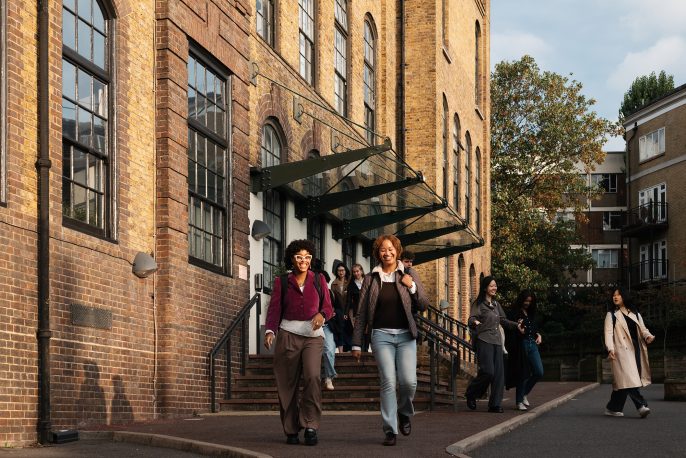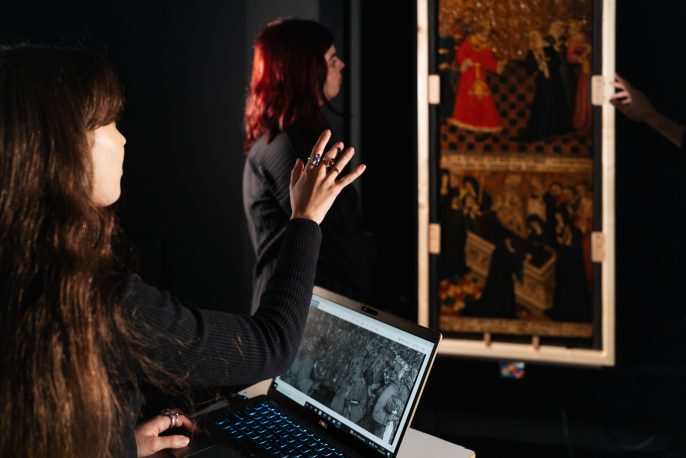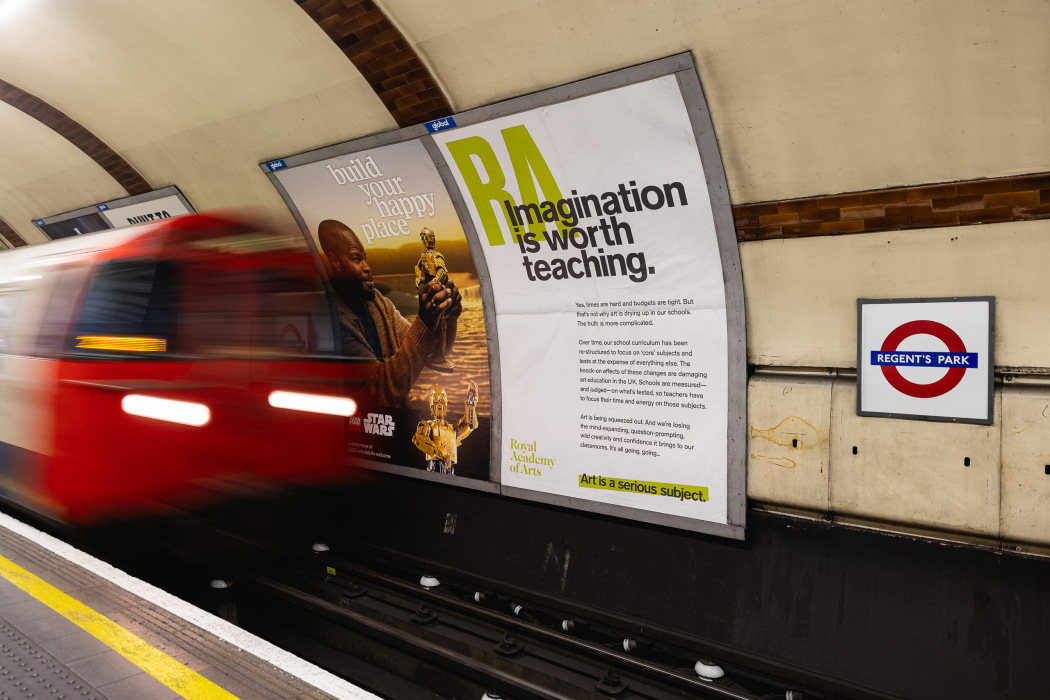
In October 2024, as we prepared this year’s issue of Immediations for print, a number of acid-green and white posters appeared around London, declaring that ‘Art is a serious subject’ and ‘Imagination is worth teaching.’ This campaign, driven by the Royal Academy, challenged recent attacks on the arts in education, which have segregated our field from so-called ‘strategically important’ subjects.1
The precarious position of the arts, culture, and heritage has been at the forefront of many of our minds this last year. Warwick University’s State of the Arts report, published in July, highlighted that, despite ninety-one per cent of the UK population engaging with ‘the arts’ over the past year, we have one of the lowest levels of government spending on ‘arts’ per capita in Europe.2 The number of hours of arts education in state-funded secondary schools has fallen by almost a quarter since 2011; and since 2021, arts subjects in higher education have faced up to fifty-percent cuts in funding. Councils across the country, including Birmingham and Suffolk, cut one hundred per cent of their arts and heritage spending, leaving museum collections and people’s access to art at risk.
War, climate crises, and political instability have put human lives and cultural heritage at peril worldwide. Israeli airstrikes in Gaza and the continued Russian offensive in Ukraine have devastated many thousands of lives and hundreds of museums, erasing cultural heritage held within the people and institutions destroyed; and climate change has led to unprecedented levels of flooding in Sudan, Brazil, Southeast Asia, and Britain, displacing millions and leading to damage to cultural heritage sites and museums; and this year, ‘the largest election year in history,’ with new politicians elected across the globe, has left constituents uncertain about the future of their countries’ support for culture, arts, and education.3 It would be no exaggeration to say that the last year has left many of us ‘on edge.’
In light of these issues, we are pleased to highlight how the wealth of postgraduate research at the Courtauld resists this attack on the arts and humanities and engages with these issues sensitively and innovatively. From Alice M. Chambers’ consideration of the visual culture surrounding natural disasters in her article on earthquakes in the early modern Atlantic world, to the fragility of the body and autonomy under political totalitarianism explored by Rebecka Öhrström Kann in her article on Tibor Hajas’ Dark Flash, the edge between existence and disappearance—and the role of art in capturing those fleeting moments—emerges repeatedly.
Cultural erasure is a particularly strong theme in this engagement with precarity: Grace Fannon’s article on the performance of British maritime identity in the Atlantic world of the eighteenth century highlights how this national performance relied on the marginalisation and erasure of other cultural identities. In the same vein, Joseph Rosalind-Hayat’s review of Ainu Stories at Japan House, London and Sarah Brokenborough’s review of Ancestral Places: People of African Descent at Tudor Place in Washington, DC address the systemic erasure of indigenous and Black artistic histories respectively. Each raises questions about how visual culture and its display may resurrect these precarious cultural stories.
The articles in this issue also frequently reach across the disciplines and across geographies challenging where, or even if, we may find the edges of art history. Bianca Arthur-Hull’s article looks beyond the canonical understanding of the Italian Renaissance by exploring the religious site of the Sacro Monte di Varallo, where devotional works in diverse media move past verisimilitude to evoke and invoke the divine. Rachel Alban considers how looking to the literal edges of the page in Safavid manuscripts offers a new understanding of the painted image, demonstrating how disciplinary intersections with book history enrich our understanding of art. Far from precarious, the rich breadth of geographies, periods, and approaches among the articles in this issue shows that there is no shortage of imagination in the teaching and research of our postgraduate community
This issue features an interview with London-based artist and art historian Bunmi Agusto, conducted by Tatjana Schaefer and Rada Georgieva. Recently named one of Bloomberg’s ‘New Contemporaries,’ Bunmi’s work explores crossed boundaries, with her individual pieces in varied media and scales reflecting a captivating personal worldview. The interviewers recalled the opportunity to talk with Bunmi as precious experience that provided a chance to hear the artist’s reflections on the profound world-building character of her work. We are delighted to present the interview and Bunmi’s work to our readers as an invitation to reconsider the idea of the edge as a way to connect across times, places, and realities.
We extend our warmest gratitude to our External Advisory Group, Leyla Bumbra, Dr Acatia Finbow, and everyone at the Research Forum; our designers Kit Moran (print) and Grace Williams (online); and Hattie Spires (Editor-in-Chief, Immediations 2023).
This issue has been selected and edited by Editors-in-Chief Alice Dodds and Emma Iadanza, along with the editorial board: Zoe Bomberg-McCarthy, Sophia Dumoulin, Rada Georgieva, Ricardo Mandelbaum Balla, and Tatjana Schaefer. For their diligence, humour, and unending effort, they have our most sincere thanks.
Citations
[1] Gavin Williamson to the Office for Students, 19 January 2021.
[2] Campaign for the Arts & University of Warwick, The State of the Arts, Campaign for the Arts & Centre for Cultural and Media Policy Studies, University of Warwick, July 2024.
[3] Amy Davidson Sorkin, “The Biggest Election Year in History,” The New Yorker, 7 January 2024.
Editorial Group
Alice Dodds (Editor-in-Chief)
Emma Iadanza (Editor-in-Chief)
Zoe Bromberg-McCarthy
Sophia Dumoulin
Rada Georgieva
Ricardo Mandelbaum Balla
Tatjana Schaefer
Publisher
The Courtauld Institute of Art
Somerset House, Stand, London WC2R 0RN
Immediations is published annually.
Further information:
http://courtauld.ac.uk/research/publications/immediations
© 2025 The Courtauld Institute of Art, London Designed by Kit Moran
Printed by N2 Group with thanks to James Hallam
External Advisory Board
Susan Aberth (Bard College)
Simon Baker (Maison européenne de la photographie)
Djurdja Bartlett (London College of Fashion)
Tessel M. Bauduin (Universiteit van Amsterdam)
Jane Bradney (Institute of Historical Research)
Wolfgang Brückle (Lucerne University of Applied Sciences and Arts)
Molly Brunson (Yale University)
Caroline Campbell (The National Gallery, London)
Annemarie Weyl Carr (Southern Methodist University)
Judith Clark (London College of Fashion)
David Peters Corbett (University of East Anglia and The Courtauld)
Finola O’Kane Crimmins (University College Dublin)
David Cunningham (University of Westminster)
Allison Deutsch (Birkbeck, University of London)
Julien Domercq
Michael Duffy (MoMA, New York)
Helen Evans (Metropolitan Museum of Art)
Kate Flint (University of Southern California)
Michelle Foot (University of Edinburgh)
Jacob Gaboury (University of California Berkeley)
Rhonda Garelick (University of Nebraska- Lincoln)
Timothy Gitzen (University of Hong Kong)
Linda Goddard (University of St Andrews)
Pia Gottschaller (The Courtauld)
Ari Larissa Heinrich (Australian National University)
Isabel Horovitz (The Painting Conservation Studio)
Sarah James
Alexandra Kaczenski
Rebecca Karl (New York University)
Sabine Kriebel (University College Cork)
Deborah Lewer (University of Glasgow)
Anna Lovatt (Southern Methodist University)
Angeliki Lymberopoulou (Open University)
Vasileios Marinis (Yale University)
Malcolm Miles (University of Plymouth)
Martin Myrone (Tate Britain)
Diana Newall (Open University)
Jeanne Nuechterlein (University of York)
Anna Russakoff (American University of Paris)
Wendy Salmond (Chapman University, CA)
Stephanie Schwartz (University College London)
Nathaniel Silver (Isabella Stewart Gardner Museum)
Camilla Smith (University of Birmingham)
Frances Spalding (University of Cambridge)
Catherine Spencer (University of St Andrews)
Anne Rudloff Stanton (University of Missouri)
John-Paul Stonard (Burlington Magazine)
Lisa Turvey (Artforum)
William Tronzo (University of California San Diego)
Sarah Tyler Brooks (James Madison University)
Jane Tynan (Vrije Universiteit Amsterdam)
Sabine Wieber (University of Glasgow)
Beth Williamson (University of Bristol)
Kim Woods (Open University)
Peter Zusi (University College London)
Cover
Front: Bunmi Agusto, Reaching Through Worlds, 2023. Pastel pencil, coloured pencil, ink and acrylic on pastel paper. Private Collection. Courtesy of the artist.
Back: Bunmi Agusto, Lead The Way Out, 2021. Pastel pencil on sandpaper and coloured pencil and ink on paper. Private Collection. Courtesy of the artist.
Immediations is an annual, peer-reviewed journal of art history. The editors welcome submissions from current members of the post-graduate research community of The Courtauld Institute of Art and from pre-doctoral and recent post-doctoral scholars who have spent part of their postgraduate career there.
Every effort has been made to contact the copyright holders of images reproduced in this journal. All rights reserved. No part of this publication may be reproduced, stored in a retrieval system, or transmitted in any way or form or by any means electronic, mechanical, photocopying, recording, or otherwise, without the prior permission in writing from the publisher.
